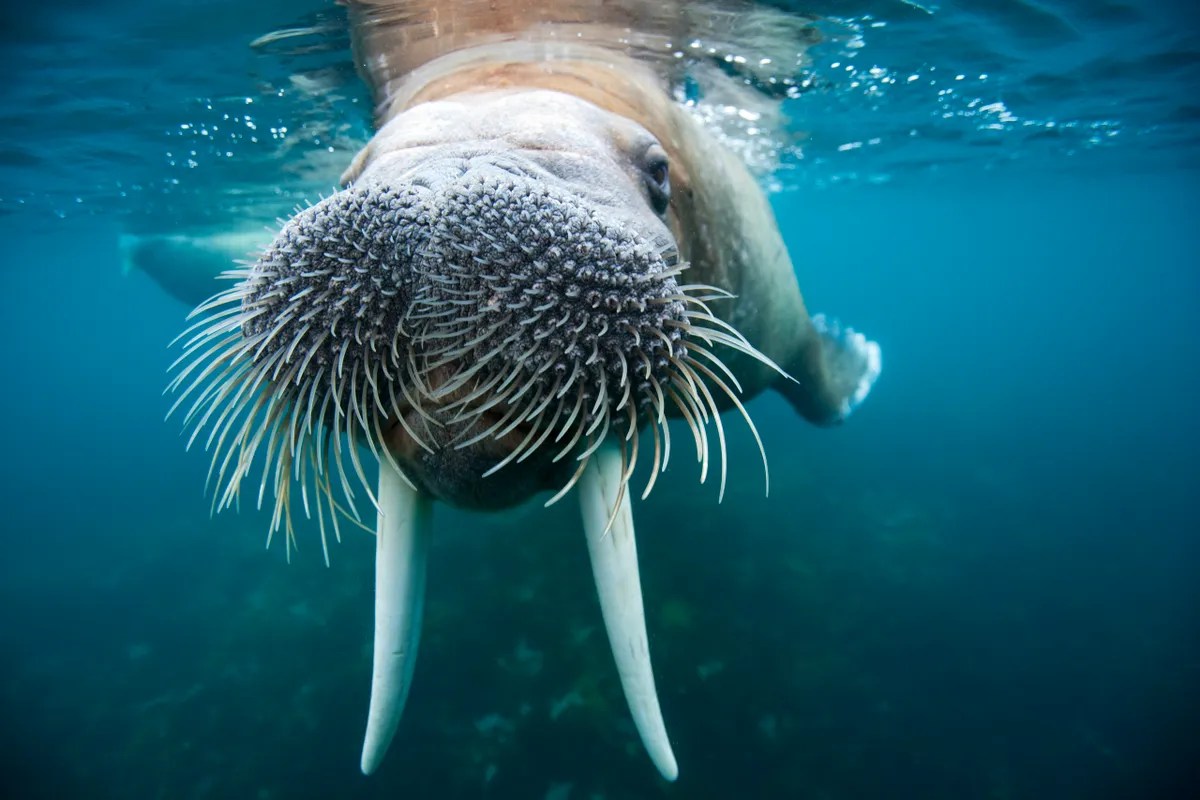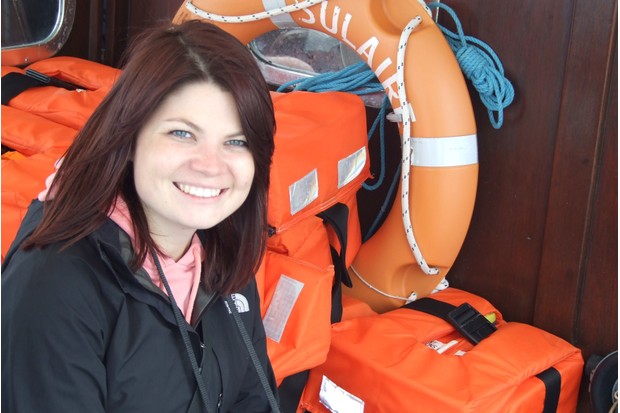Walruses live in the Arctic and sub-Arctic. They are one of the largest pinnipeds (meaning fin footed) and are related to seals and sealions says Jo Price.
- Sea lion vs seal: What's the difference between these two popular pinnipeds
- Discover the Arctic animals that not only survive, but also thrive, in this inhospitable freezing landscape
Their Latin name, Odobenus rosmarus, translates as “tooth-walking sea-horse” and refers to their most distinguishable feature – large tusks.
What do walruses eat?
These marine mammals feed in shallow, coastal areas and usually only embark on short dives. They make foraging trips that can last from a few hours to several days. The main prey of walruses is bivalve molluscs that they look for using their super sensitive whiskers on or in soft sediment. They also eat worms, snails, crabs, amphipods, shrimps, sea cucumbers, tunicates, and slow-moving fish.
Where do walruses live?
Walruses are extant in Canada, Greenland, Russia, Svalbard and Jan Mayen, and Alaska in the US. The species is documented as “presence uncertain and vagrant” in Belgium, Denmark, Finland, France, Germany, Iceland, Ireland, Japan, Netherlands, Norway, Spain, Sweden, UK and Maine, Massachusetts in the US.
There have been several sightings of the species appearing outside of its usual range in recent years, particularly in Europe, which have grabbed the attention of the media.
What habitat do walruses need to flourish?
In addition to large areas of shallow water, walruses need access to open water to forage and rely on haul out spots that are close to feeding areas. According to the IUCN, the preferred haul out platform is sea ice, but walruses do use haul out sites on land in the summer and autumn.
Haul out areas are used to rest between foraging trips, breeding, giving birth and nursing their young. They are also used for shelter from rough seas, and from predators such as polar bears and killer whales.
What do walruses look like?

A walrus is a large, blubbery marine mammal with long tusks and a whiskered face. It has a small eyes, brown skin, Front and hind flippers.
Do walruses have ears?
Yes walruses have ears - but unlike many other mammals who have large out ears walruses just have holes behind the eyes with no ear flaps
How big are walruses?
Pacific walrus males can reach 3.6m in length and weigh 880 to 1,557kg; adult females are about 3m and weigh 580 to 1,039kg. Atlantic walrus adults are shorter and lighter.
How do walruses breed?
Walrus courtship and mating occurs in the winter and calves are usually born the following May (females usually produce one calf every three years). During the breeding season mature males exhibit aggressive behaviour such as vocalisations, tusk wielding, and confrontation as they fight for dominance and access to females.
Are walruses social animals?
Yes, they’re extremely gregarious and gather on ice or land in groups, and at sea, they usually travel in groups too. These fin-footed creatures are very sensitive to disturbance and noise.
Therefore, during their mass gatherings, stampedes towards the water can occur if they’re frightened; this can be caused by human disturbance, low-flying aircraft and near-shore vessels. Outside of the breeding season, males are often found in areas away from females and their calves.
What are baby walruses called?
Baby walruses are called calves
How many subspecies of walrus are there?
There are two subspecies of walrus: the Atlantic walrus (Odobenus rosmarus rosmarus) and the Pacific walrus (Odobenus rosmarus divergens). According to the IUCN, the Atlantic walrus occurs from the eastern Canadian Arctic to the western Kara Sea.
The Pacific walrus normally ranges from the Bering and Chukchi Seas, which constitute the centre of its range, to the Laptev Sea in the west and the Beaufort Sea in the east.
How do walruses keep warm?
Thanks to thick layers of fat beneath their skin, walruses stay insulated and are able to cope with temperatures as low as -35°C.
- Why are walruses so chubby? Just how fat are they? The secret behind their flabby obese look
- Are blubber and fat the same thing? Why blubber is always fat, but fat isn’t always blubber
- When do seas become oceans?
Why do walruses turn pink?
Walruses are brown but can turn white after diving in icy cold water for long periods of time or even pink when they are warm (to diffuse excess body heat). This is caused by their ability to vary the blood supply to the surface of their bodies if required.
Why do they have tusks?
Both males and females have tusks, which can grow up to 1m long and weigh 5kg in large bulls (males). In addition to fighting, walruses use their tusks to haul themselves out of the water and onto land or ice, to keep breathing holes open in the ice, and to defend themselves against predators.
Why do they have pharyngeal pouches?
Walruses have specialised air sacs located in the throat, known as pharyngeal pouches. These pouches can be inflated with air, allowing the walruses to float upright in the water and amplify vocalisations.
How fast do walruses swim?
Walruses are pretty speedy mammals for their size when it comes to swimming with a top speed of up to 35km/h
How long do walruses live?
The average lifespan of a walrus is up to 40 years
Do walruses face any threats?
Global warming and associated sea ice declines threaten walrus populations because suitable areas for breeding and pupping are reduced, and access to offshore feeding areas becomes limited. If walruses must swim further to find food, more energy is required, which can lead to exhaustion and lower survival rates.
When more walruses are forced to rely on land-based haul out sites it can result in deaths caused by overcrowding and increase the risk of stampedes. The reduction in sea ice has also led to expanded shipping and development of oil and gas fields in parts of the walrus’ range, increasing the risk of spills, pollution discharge and disturbances.
Are walruses hunted?
Walrus populations were severely depleted by commercial hunting from the 18th through to the mid-20th century, but the species now receives legal protection through international agreements and national laws.
Today, subsistence harvests by native people continue in Canada, Greenland, Alaska, and Russia.
- World's rarest whales and dolphins: Discover beautiful cetaceans in danger of disappearing forever
- This ocean giant's mouth is as wide as a car – and an expedition team just filmed inside it
- How deep is the deepest part of the ocean?
- Which mammal holds its breath the longest? Meet the extreme deep-sea diver that can hold its breath for almost 4 hours
